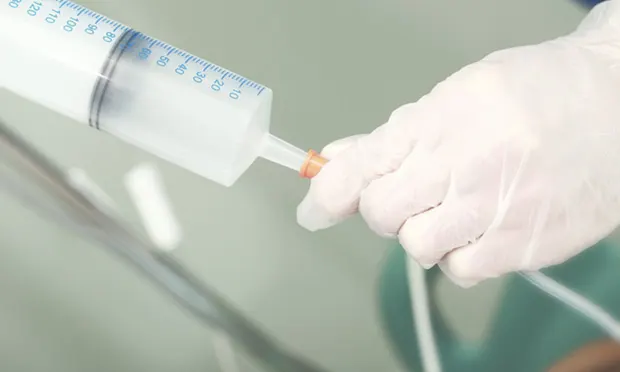Enteral Nutrition: Tube Feeding
Craig Datz, DVM, MS, DABVP (Canine & Feline), DACVN, University of Missouri
Allison Wara, DVM, University of Missouri College of Veterinary Medicine

What diets can be fed to dogs and cats via enteral feeding tubes, and how should they be administered?
Assisted feeding is a procedure used to supply nutrition to animals that are not eating voluntarily. Tube feeding, also called enteral nutrition, is becoming more widespread because of the increased availability of specialty and 24-hour hospitals, greater selection of diets and techniques, and improved patient outcomes; several studies indicate it can result in lower patient morbidity and mortality, as well as shorter hospital stays.1
Feeding Tubes
The most common types of feeding tubes are nasoesophageal or nasogastric (NE, NG), esophagostomy (E), gastrostomy (PEG or G), and jejunostomy (J). Liquid enteral diets are used for NE, NG, and J tubes because of their narrow diameter (5- or 8-French). For larger feeding tubes (E and G tubes, 12–24 French), other diets may be used provided they are properly prepared.
The following provides an overview on selecting types and calculating amounts of diets for E- and G-tube assisted feeding.
Diet Selection
Several critical care diets can be fed directly through large feeding tubes or after diluting with small amounts of water. Compared with maintenance diets, they are relatively high in protein and fat and low in carbohydrates. Patients may require different types of diets depending on their medical condition; for example, a cat with kidney disease may benefit from a diet restricted in protein and phosphorus, whereas a dog with acute pancreatitis might need a diet restricted in fat. Likewise, puppies and kittens require diets formulated for growth. Selection is not limited to critical care diets; almost all canned diets can be prepared and fed through larger feeding tubes.
How Much & How Often?

The first step is to calculate the patient’s daily resting energy requirement (RER) at current body weight (BW; see RER Calculation). If the patient is obese (>20% above ideal BW), then RER may be calculated at ideal or target weight.2 Multiples of RER (illness factors) are no longer recommended because of the risk for complications from overfeeding.3
RER Calculation
Equation to determine resting energy requirement: 70 × BWkg<sup0.75sup> = kcal/d
For example: 10-kg dog: 70 (10)<sup0.75sup> = 70 × 5.6 = 394 kcal/d
If there is no exponent key on a handheld calculator (yx), the square root key (√) can be used. Enter BW and multiply by itself twice (BW × BW × BW), then press square root key twice (√,√). Multiply the result by 70.
For example:
10-kg dog: 10 × 10 × 10 = 1000
√,√ = 31.6, 5.6
× 70 = 394 kcal/d
The second step is to determine how many times per day the patient will be tube-fed (eg, 4–6 feedings). The RER (kcal/d) is divided by the number of feedings for the kcal/feeding. The final step is to divide the kcal/feeding by the kcal/mL of the diet for the number of mL/feeding (see Example Feeding Plan).
Overfeeding or rapid reintroduction of enteral nutrition may lead to vomiting, diarrhea, and/or discomfort. In rare cases, this can lead to refeeding syndrome, which can result in sudden hypokalemia, hypophosphatemia, and hypomagnesemia. For patients with prolonged history of anorexia (eg, starvation, hepatic lipidosis) that are at risk for refeeding syndrome, a longer, slower ramp-up may be needed. On day 1, 25% to 33% of the daily RER can be given. On day 2, this amount can be increased to 50% to 67% RER; on day 3, 75% to 100% RER; and on day 4 and beyond, 100% RER until the patient resumes voluntary food intake.4 Most animals with E- and G-tubes do well with 3 to 6 feedings per day. Feeding once or twice per day is often not tolerated because of volume overload.
Example Feeding Plan
An older dog with chronic kidney disease is anorectic and losing weight. The current BW is 7 kg. A 14-French esophagostomy tube is placed to provide nutritional support:
Calculate RER at current BW: 70 × (7)<sup0.75sup> = 301 kcal/d.
Determine starting amount for feeding and rate of increase. If there are no complications, this dog may receive 100 kcal on day 1, 200 kcal on day 2, 300 kcal on day 3, continuing at 300 kcal/d long term or until voluntary intake resumes.
Determine number of times per day the dog will be fed. Aim for 3–6 feedings per day as needed.
Calculate kcal/feeding. For example, if feeding 5× per day, day 1 = 100 kcal/5 = 20 kcal; day 2 = 200 kcal/5 = 40 kcal, etc.
Choose an appropriate diet. For chronic kidney disease, a canned renal diet is indicated. The selected example diet weighs 370 g and has 458 kcal/can.
Using a blender, add measured amounts of water until the slurry is liquefied and flows easily through a 14-French tube. In this case, 200 mL of water blended with 1 can of diet results in an appropriate consistency.
Calculate energy density (kcal/mL) of the slurry. Assume 1 g of diet is equivalent to 1 mL. Add the weight of the diet in grams per can to the amount of water (in mL) needed to make a slurry: 370 g + 200 mL = 570 mL. Divide the kcal/can by the final volume of the slurry: 458 kcal/570 mL = 0.8 kcal/mL.
Divide the kcal/feeding by the kcal/mL of the slurry to calculate mL to administer at each feeding. On day 1, this dog will receive 20 kcal/0.8 = 25 mL/feeding. On day 2, 40 kcal/0.8 = 50 mL/feeding, etc.
Monitor the dog for changes in BW and complications, such as discomfort and vomiting. Once the dog is receiving its full calculated RER, if the owner wants to try 4 feedings per day, the calculation will be 300 kcal/4 = 75 kcal, 75/0.8 = 94 mL/feeding. This larger volume may or may not be tolerated by the patient, so careful monitoring is necessary.
Preparing Canned Diets for Tube Feeding
After an appropriate diet is selected for the patient’s needs, it must be diluted and mixed sufficiently to form a slurry or liquefied diet (see Enteral Nutrition: Step-by-Step).
To determine the kcal/mL of the slurry, the product weight in grams (g/can) and the kcal/can of the diet must first be determined. This information may be printed on the product label, but the company, feeding guide, or website may need to be consulted. The next step is to determine how much water will be added to ensure an adequate consistency of the slurry. The number of grams of diet and number of mL of water are then added together (or the final volume of the slurry is determined in mL). Finally, the kcal/can can be divided by the total mL to determine the kcal/mL.
Conclusion
Tube feeding is an effective method of providing nutrition to sick and injured patients that are unable to voluntarily consume sufficient amounts or types of food. It is important to calculate the amount to feed per day using the RER equation, and it is equally important to determine the kcal/mL of the slurry administered so that appropriate feeding instructions can be written and followed.